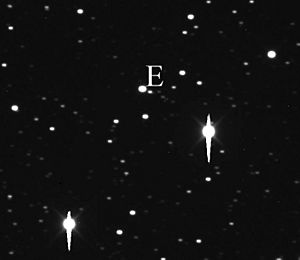52 Europa facts for kids

Europa as seen in 24 inch telescope
|
|
| Discovery | |
|---|---|
| Discovered by | H. Goldschmidt |
| Discovery date | February 04, 1858 |
| Designations | |
| 1948 LA | |
| Main belt | |
| Orbital characteristics | |
| Epoch November 26, 2005 (JD 2453700.5) | |
| Aphelion | 511.201 Gm (3.417 AU) |
| Perihelion | 416.621 Gm (2.785 AU) |
| 463.911 Gm (3.101 AU) | |
| Eccentricity | 0.102 |
| 1994.629 d (5.46 a) | |
|
Average orbital speed
|
16.87 km/s |
| 70.730° | |
| Inclination | 7.466° |
| 128.992° | |
| 343.553° | |
| Physical characteristics | |
| Dimensions | 360×315×240 km[1][2] |
| Mass | 5.2±1.8×1019 kg[3] |
|
Mean density
|
3.6±1.2 g/cm³ |
| ~0.11 m/s² | |
| ~0.20 km/s | |
| 0.2347 d [4] | |
| Albedo | 0.058 [1] |
| Temperature | ~173 K max: 258K (-15 °C)[5] |
|
Spectral type
|
C-type asteroid |
| 6.31 | |
52 Europa is a very large asteroid that orbits the Sun. It was discovered on February 4, 1858, by a scientist named Hermann Mayer Salomon Goldschmidt. This space rock is about 289 kilometers (180 miles) wide.
Europa is one of the biggest asteroids known. It is the seventh largest by its size and the sixth largest by its weight in the main asteroid belt. It holds almost 2% of all the mass in the entire main asteroid belt.
Contents
Naming Europa
This asteroid is named after Europa. She was a princess in ancient Greek mythology. In these old stories, Europa was one of the people that the god Zeus fell in love with.
What is Europa Made Of?
52 Europa is a very dark asteroid. It is known as a C-type asteroid. This means it is rich in carbon, which makes it appear very dark. It is the fourth largest of all the C-type asteroids.
Scientists have studied Europa's surface. They found signs of minerals like olivines and pyroxenes. These are common minerals found in many rocks on Earth and in space.
How Does Europa Spin?
Scientists study how asteroids spin by looking at their brightness. This is called a light curve. For 52 Europa, understanding its spin has been tricky. For a long time, experts debated if it spun in 5.5 hours or 11 hours.
Now, we know that Europa spins forward, which is called a prograde rotation. However, the exact direction its pole points in space is still a bit unclear. It spins completely around in about 0.23 days, which is a little over 5.5 hours.
A Case of Mistaken Identity
In 1934, astronomers thought they had found a new star. They called it CV Aquarii. But later, they realized it was not a star at all! It was actually 52 Europa that they had seen. This shows how sometimes objects in space can be mistaken for others.
Images for kids
See also
 In Spanish: (52) Europa para niños
In Spanish: (52) Europa para niños


